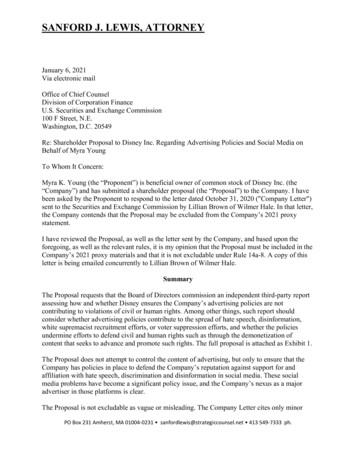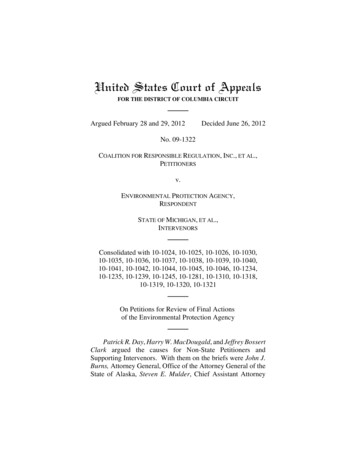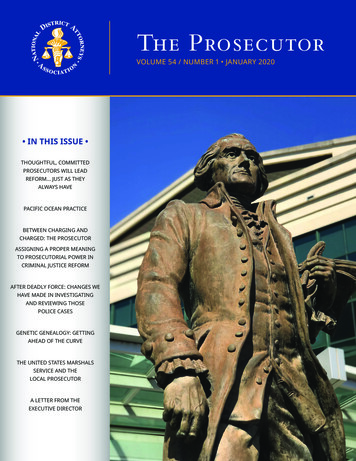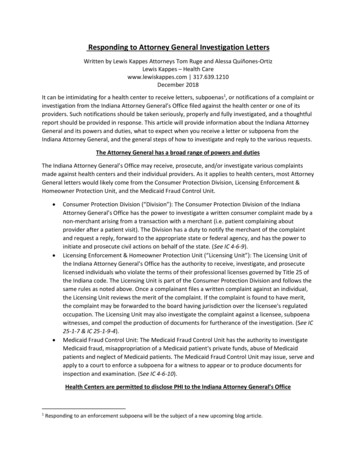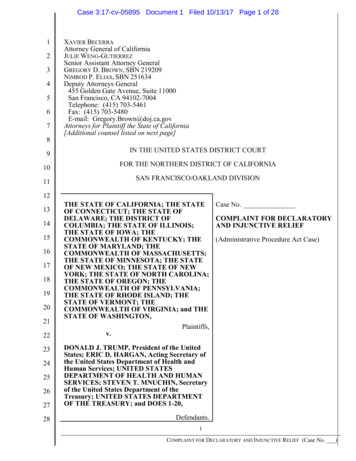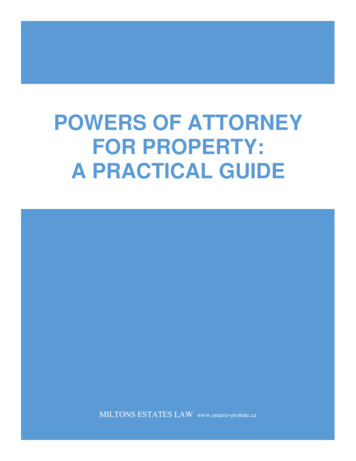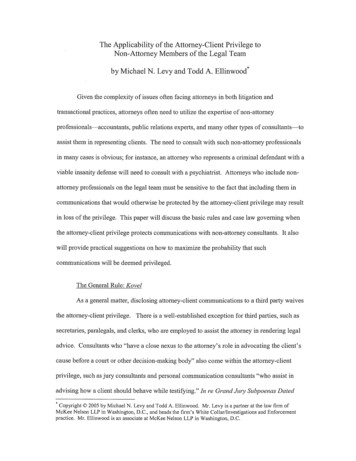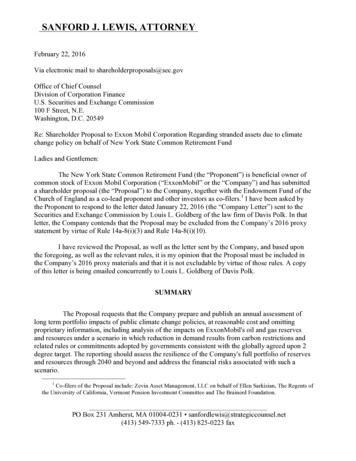
Transcription
SANFORD J. LEWIS, ATTORNEYFebruary 22, 2016Via electronic mail to shareholderproposals@sec.govOffice of Chief CounselDivision of Corporation FinanceU.S. Securities and Exchange Commission100 F Street, N.E.Washington, D.C. 20549Re: Shareholder Proposal to Exxon Mobil Corporation Regarding stranded assets due to climatechange policy on behalf of New York State Common Retirement FundLadies and Gentlemen:The New York State Common Retirement Fund (the “Proponent”) is beneficial owner ofcommon stock of Exxon Mobil Corporation (“ExxonMobil” or the “Company”) and has submitteda shareholder proposal (the “Proposal”) to the Company, together with the Endowment Fund of theChurch of England as a co-lead proponent and other investors as co-filers.1 I have been asked bythe Proponent to respond to the letter dated January 22, 2016 (the “Company Letter”) sent to theSecurities and Exchange Commission by Louis L. Goldberg of the law firm of Davis Polk. In thatletter, the Company contends that the Proposal may be excluded from the Company’s 2016 proxystatement by virtue of Rule 14a-8(i)(3) and Rule 14a-8(i)(10).I have reviewed the Proposal, as well as the letter sent by the Company, and based uponthe foregoing, as well as the relevant rules, it is my opinion that the Proposal must be included inthe Company’s 2016 proxy materials and that it is not excludable by virtue of those rules. A copyof this letter is being emailed concurrently to Louis L. Goldberg of Davis Polk.SUMMARYThe Proposal requests that the Company prepare and publish an annual assessment oflong term portfolio impacts of public climate change policies, at reasonable cost and omittingproprietary information, including analysis of the impacts on ExxonMobil's oil and gas reservesand resources under a scenario in which reduction in demand results from carbon restrictions andrelated rules or commitments adopted by governments consistent with the globally agreed upon 2degree target. The reporting should assess the resilience of the Company's full portfolio of reservesand resources through 2040 and beyond and address the financial risks associated with such ascenario.1Co-filers of the Proposal include: Zevin Asset Management, LLC on behalf of Ellen Sarkisian, The Regents ofthe University of California, Vermont Pension Investment Committee and The Brainerd Foundation.PO Box 231 Amherst, MA 01004-0231 sanfordlewis@strategiccounsel.net(413) 549-7333 ph. (413) 825-0223 fax
Exxon Mobil - Stranded AssetsFebruary 22, 20162In response to a previous shareholder proposal, the Company issued a March 2014report entitled Energy and Carbon – Managing the Risks (“2014 Report”) asserting its opinionthat it is unlikely global and national governments will enact policies consistent with the globalgoal of constraining carbon as needed to contain global temperature rise to 2 degrees Celsius.Thus, the Company declined to calculate the economic impact on its portfolio should such policiesbe put into place.The Company asserts that the Proposal is excludable under Rule 14a-8(i)(3) eitherbecause it fails to define terms or fails to address the central aspects of its implementation.However, the meaning of “public climate policies consistent with the 2 degree target” is clear. It isclear within the Company’s own 2014 Report, and within current policymaking circles, investoranalysis, public and media discussion of this controversy, and also in reading the Proposal in itsentirety. The fact that global solutions and approaches to meeting the 2 degree target are stillsubject to innovation and policy refinement does not render the Proposal vague. Enough is knownabout the general direction of public policy related to the 2 degree target and its potentialrestrictions on carbon and fossil fuels to allow the Company to assess these issues, and themeaning of the Proposal is neither unclear to shareholders nor to Company management. Despite azealous effort by the Company to create uncertainty and forego action, the Proposal is notexcludable as vague or misleading.The Company also asserts that it has substantially implemented the Proposal through itsexisting disclosures in which it concluded it is highly unlikely that global governments will imposerestrictions on fossil fuels consistent with the 2 degree scenario. In support of its argument that theProposal is excludable under Rule 14a-8(i)(10), the Company notes that it issued the 2014 Reportin response to a previous shareholder proposal, in which it stated the Company is “confident thatnone of our hydrocarbon reserves are now or will become stranded” through 2040. The presentProposal is clearly written as a response to that prior Company report, which the Proponent, theco-lead proponent and co-filers believe dramatically underestimates the prospect for globalrestrictions to meet the 2 degree target. The essential purpose of the Proposal is for the Companyto calculate the potential losses in the event its optimistic conjectures prove false. As such, theCompany’s reporting, including the 2014 Report, does not meet the essential purpose of thecurrent proposal. The Company has not issued a report fulfilling these purposes, and therefore theProposal is not substantially implemented.Moreover, the Company’s current use of a carbon proxy price, which it asserts as itsmeans of calculating climate policy impacts, merely amplifies and reflects its optimisticassessments of national and global climate policies. The Company Letter notes that ExxonMobil issetting an internal price as high as 80 per ton; in contrast, the 2014 Report notes a carbon price of 1000 per ton to achieve the 450 ppm (2 degree scenario) and the Company reportedly statedduring the recent Paris climate talks that a 1.5 degree scenario would require a carbon price as highas 2000 per ton within the next hundred years. Thus, with an order of magnitude gap between theCompany’s proxy pricing and its statements regarding what would be needed to restrict carbonconsistent with the 2 degree goal, it is clear that ExxonMobil’s current carbon pricing does not
Exxon Mobil - Stranded AssetsFebruary 22, 20163reflect a calculation of the costs and risks to the Company if the 2 degree scenario is implementedby policymakers.THE PROPOSALThe Proposal states:“RESOLVED: Shareholders request that by 2017 ExxonMobil publish an annual assessment oflong term portfolio impacts of public climate change policies, at reasonable cost and omittingproprietary information. The assessment can be incorporated into existing reporting and shouldanalyze the impacts on ExxonMobil's oil and gas reserves and resources under a scenario in whichreduction in demand results from carbon restrictions and related rules or commitments adopted bygovernments consistent with the globally agreed upon 2 degree target. The reporting should assessthe resilience of the company's full portfolio of reserves and resources through 2040 and beyondand address the financial risks associated with such a scenario.Supporting Statement:It is our intention that this be a supportive but stretching resolution that ensures the long-termsuccess of the company.Recognizing the severe and pervasive economic and societal risks associated with a warmingclimate, global governments have agreed that increases in global temperature should be held below2 degrees Celsius from pre-industrial levels (Cancun Agreement). Pursuant to the Durban Platform,184 parties submitted plans to reduce greenhouse gas emissions in advance of the 21st Conferenceof the Parties. In November 2014 the United States and China agreed to policy and regulatoryactions to reduce greenhouse gas emissions and re-affirmed and expanded those actions inSeptember 2015.ExxonMobil recognized in its 2014 10-K that "a number of countries have adopted, or areconsidering adoption of, regulatory frameworks to reduce greenhouse gas emissions," and thatsuch policies, regulations, and actions could make its "products more expensive, lengthen projectimplementation timelines and reduce demand for hydrocarbons," but ExxonMobil has notpresented any analysis of how its portfolio performs under a 2 degree scenario.In response to a previous shareholder resolution regarding Carbon Asset Risk, ExxonMobilasserted "that an artificial capping of carbon-based fuels to levels in the 'low carbon scenario' [suchas IEA 450ppm] is highly unlikely" and did not test its portfolio against a 2 degree scenario.However, ExxonMobil's peers, Shell, BP, and Statoil have recognized the importance of assessingthe impacts of these scenarios by endorsing the "Strategic Resilience for 2035 and beyond"resolutions that received almost unanimous investor support in 2015. BHP Billiton now publishes a"Climate Change: Portfolio Analysis" evaluating its assets against 2 degree scenarios, andConocoPhillips states that it stress tests its portfolio against 2 degree scenarios. More recently, tenmajor oil and gas companies have announced that they will support the implementation of clearstable policy frameworks consistent with a 2 degree future.
Exxon Mobil - Stranded AssetsFebruary 22, 20164This resolution aims to ensure that ExxonMobil fully evaluates and mitigates risks to the viabilityof its assets as a result of public climate change policies, including in a 2 degrees scenario.”BACKGROUNDGrowing Financial Risks of Climate ChangeClimate change and the risks it is generating for companies have become major concernsfor investors. These concerns have been magnified by the 21st Session of the Conference of theParties (COP 21) in Paris, where 195 global governments agreed to restrict greenhouse gas (GHG)emissions to no more than 2 degrees Celsius from pre-industrial levels and submitted plans tobegin achieving the necessary GHG emission reductions. In the agreement, signatories alsoacknowledged the need to strive to keep global warming to 1.5 degrees, recognizing current andprojected harms to low lying islands. Although the reduction goals are not set forth in anenforceable agreement, the parties put mechanisms in place for transparent reporting by countriesand a ratcheting mechanism every five years to create accountability for achieving these goals.U.N. Secretary General Ban Ki-moon summarized the Paris Agreement as follows: “The onceunthinkable [global action on climate change] has become the Unstoppable.”2Achievement of even a 2 degree goal requires net zero global emissions to be attainedby 2100.3 Achieving net zero emissions this century means that the vast majority of fossil fuelreserves cannot be burned. As noted by Mark Carney, the President of the Bank of England, thecarbon budget associated with meeting the 2 degree goal will “render the vast majority of reserves‘stranded’ – oil, gas, and coal that will be literally unburnable without expensive carbon capturetechnology, which itself alters fossil fuel economics.”4As the profound implications of a warming world resonate with global policymakers,and a credible path to action has been initiated, the need for companies to provide reliableinformation on the financial risks and opportunities associated with climate change has only beenunderscored. Investors require clear, transparent, and comparable information about climatechange impacts to make informed assessments about their use of capital. This need for clear andcomplete information has been echoed by a range of financial regulatory agencies and institutions,from the Bank of England to the Financial Stability Board (FSB) which recently set up a TaskForce on Climate-Related Financial Disclosures (TCFD) under the chairmanship of MichaelBloomberg. The goal of the TCFD is to develop voluntary, consistent climate-related financial riskdisclosure mechanisms to provide critical informative information to investors, lenders, insurers,and other stakeholders. France recently created mandatory climate risk disclosure requirements.52COP21: UN chief hails new climate change agreement as ‘monumental ewsID 52802#.Vq751VJRJuQ3United Nations Environmental Program. UN Says Global Carbon Neutrality Should Be Reached by Second Half ofCentury, Demonstrates Pathways to Stay Under 2 C. Nov, 2014.4Bank of England. Breaking the tragedy of the horizon - climate change and financial stability - speech by MarkCarney. Sept, 2015. speeches/2015/844.aspx#15Pensions & Investments. France to require institutional investors to disclose carbon exposure. May, tors-todisclose-carbon-exposure
Exxon Mobil - Stranded AssetsFebruary 22, 20165Australia also just announced that its Senate will conduct an inquiry into how Australiancompanies report their investments in fossil fuels and their exposure to the carbon bubble.6Global governments are now on a clearly acknowledged path to decarbonisation. Themessage of Paris and the urgency for action will have profound effects on regulatory policy,technological progress, and consumer demand in the energy sector which contributes up to 76% ofGHG emissions and is therefore ground zero for change.7 The array of climate change-related risksto oil and gas companies resulting from regulatory, technological, financing changes, andassociated demand reductions, must not only be assessed by the Company and internalized, butshared with investors to allow them to make fully formed investment decisions. In a 2010disclosure Guidance Update, the SEC recognized the need for comprehensive climate disclosure.8Over the past 5 years, the need for clear disclosure on the risks of climate change has only becomemore evident.Previous investor efforts sought and failed to encourage ExxonMobil to quantify financialrisks in the event climate policies effectively implement the 2 degree goalIn 2014, a proposal was filed by shareholders seeking a carbon asset risk report.9 TheCompany agreed to issue a report which, in name, addressed the proposal’s request. However,instead of calculating the losses associated with carbon restrictions, the Company asserted in itsreport a belief that any future capping of carbon-based fuels to the levels of a ‘low carbonscenario’ (the two degree scenario) is highly unlikely due to pressing social needs for energy. In anutshell, the Company stated quite simply:“[W]e are confident that none of our hydrocarbon reserves are now or will becomestranded.”10As reported by the BBC:“Exxon Mobil shrugs off climate change risk to profit,” BBC News, April 1, .htmlEnvironmental Protection Agency. Global Greenhouse Gas Emissions s/global.html8SEC. Commission Guidance Regarding Disclosure Related to Climate Change. .pdf9The 2014 proposal filed by Arjuna Capital and As You Sow asked ExxonMobil to “prepare a report . . on theCompany’s strategy to address the risk of stranded assets presented by global climate change, including analysis oflong and short term financial and operational risks to the [C]ompany.” However, it did not contain the specificity ofthe current Proposal. The proposal was not found excludable by the Staff, but was withdrawn after the Companyagreed to publish a report on carbon asset risk. That report, the 2014 Report, skirted the core concerns of theinvestors, instead adopting the Company’s optimistic outlook on fossil fuel restraints.710Exxon Mobil, Energy and Carbon – Managing the Risks, page 1.
Exxon Mobil - Stranded AssetsFebruary 22, 20166Exxon Mobil, the US's largest oil and gas company, said in a new report that worldclimate policies are "highly unlikely" to stop it from producing and selling fossil fuels inthe near future.The firm says its oil and gas reserves will not lose value as the world adapts to risingtemperatures.However, Exxon does not dispute that global warming is happening. As the largest oil company in the United States, the Company’s risk calculation is notonly a statement of assessment of public policy, but can also be understood as a commitment tocontinue efforts to mold public policy to promote continued fossil fuel sales. As such, the 2014Report seemed a dire warning to the global community, and showed the intent of ExxonMobil toneglect the implications of continuing to stake the Company’s future on the development, sale andpromotion of fossil fuels. This was reflected in a Financial Times headline interpreting the samereport:“Exxon warns global warming targets ‘unlikely’ to be met,” Financial Times, EdCrooks, March 31, 2014, 0144feabdc0.html#axzz40GYWRSWIExxonMobil, the US oil group, said it was “highly unlikely” that the world would cutgreenhouse gas emissions sufficiently to keep global warming within the internationallyagreed limit of 2C.Failing to meet the 2 degree goal means, according to scientists, that the world will face massivecoastal flooding, increasingly severe weather events, and deepening climate disruption. It willimpose billions of dollars in damage on the global economy, and generate an increasing number ofclimate refugees worldwide. 11ANALYSISI. The Proposal is not excludable under Rule 14a-8(i)(3) because it is neither vague normisleading.The Company asserts that the Proposal is vague and misleading, claiming that mostinvestors might not understand the low carbon scenarios set forth in the Proposal. However, the 2degree target and the policy options related to its achievement have been widely reported, andmost notably, the Company’s own 2014 Report adequately describes what it calls the low carbon/2degree scenario, if only to refute the likelihood of policymakers’ success in implementing it. The2014 Report states on page 8:11Citi GPS, Energy Darwinism II: Why a Low Carbon Future Doesn’t Have to Cost the Earth, August 2015;Department of Defense, National Security Implications of Climate Related Risks and a Changing Climate (July2015) available at e.pdf?source govdelivery
Exxon Mobil - Stranded AssetsFebruary 22, 20167One focus area of stakeholder organizations relates to what they consider the potentialfor a so-called carbon budget. Some are advocating for this mandated carbon budget inorder to achieve global carbon-based emission reductions in the range of 80 percentthrough the year 2040, with the intent of stabilizing world temperature increases not toexceed 2 degrees Celsius by 2100 (i.e., the “low carbon scenario”). A concern expressedby some of our stakeholders is whether such a “low carbon scenario” could impactExxonMobil’s reserves and operations – i.e., whether this would result in unburnableproved reserves of oil and natural gas.The report goes on to explain why the Company considers this scenario of carbon restrained fossilfuel sales so unlikely that it declined to calculate the financial implications. Thus, in 2014 theCompany had a clear sense of what it understood the 2 degree scenario to be. And, in light ofincreasing global attention to climate change, it is untenable to argue the 2 degree scenario hassomehow become less clear since then.The Staff of the Division of Corporation Finance (Staff) has already rejected argumentsrelated to purported vagueness of language similar to that of the current Proposal in The AESCorporation, Jan 19, 2016. In that instance, the proposal contained a very similar resolved clauseand supporting statement:RESOLVED: Shareholders request that AES, with board oversight, publish anassessment (at reasonable cost and omitting proprietary information) of the long termimpacts on the company's portfolio of public policies and technological advances thatare consistent with limiting global warming to no more than 2 degrees Celsius over preindustrial levels.SUPPORTING STATEMENT: Such report should assess the resilience of AES'sportfolio including under a scenario in which reduction in demand results from carbonrestrictions and related rules adopted by governments consistent with the globally agreedupon 2 degree target accompanied by continued cost reductions in clean energytechnologies (such as the IEA's 450ppm scenario). The report should assess the impactson the company's full portfolio of power generation assets and planned capitalexpenditures through 2040 and address the financial risks associated with such ascenario.AES argued that the future scenarios sought in this wording were ambiguous, for instance,"consistent with" the 2 degree target could mean technologies and policies allowing more or lessthan the target, and that the public policies that may be adopted in the future are ambiguous andunknown. The Staff rejected these arguments and found that the Proposal was not excludableunder Rule 14a-8(i)(3).As in AES, the Company here argues that the Proposal is vague and misleading because itasks the Company to assess the impact of a reduction in demand from “public climate changepolicies” consistent with the “2 degree” target:
Exxon Mobil - Stranded AssetsFebruary 22, 20168The meaning and implications of this reference to “2 degree” are not fullyexplained in the Proposal and are likely only understood and appreciated byshareholders with a significant level of knowledge and expertise regardingclimate change science and policy. Company Letter, page 4.The Company acknowledges that the 2 degree goal is widely understood among experts:Within the international expert community, “2 degree” is generally used asshorthand for a low carbon scenario under which CO2 concentrations in theearth’s atmosphere are stabilized at a level of 450 parts per million (ppm) orlower, representing approximately an 80% reduction in greenhouse gas emissionsfrom current levels, which according to certain computer simulations would belikely to limit warming to 2 degrees Celsius above pre-industrial levels and isconsidered by some to reduce the likelihood of significant adverse impacts basedon analyses of historical climate variability. Company Letter, page 4.But the Company fails to acknowledge that this widely reported goal is also consistentlyunderstood among diverse sources, including financial analysts, investment advisors, the generalpress and public, and, most importantly for purposes of this response, investors generally: Mercer,Investing in a Time of Climate Change (June 2015); BlackRock, The Price of Climate Change:Global Warming’s Impact on Portfolios (October 2015); Charles Schwab, 5 Ways ClimatePolicies May Impact Your Portfolio (December 2015); Dallas Morning News, Historic Deal toCurb Global Warming Reached (Dec. 12, 2015).The Company next asserts that there is no agreement regarding what carbon limits need tobe met by what years among members of the global scientific community citing the evolvingunderstanding of the IPCC, which in 2007 asserted that emission levels must peak by 2015, andthen in subsequent years a peak in the emission levels target was pushed back to 2030. Theexistence of evolving understanding about how to limit damage to the global ecosystem goes withthe territory of this issue; it’s not a reason for the Company to decline to examine the risks thatthese evolving policies could eventually collide with its bottom line.The Company goes on to assert that the Proposal is vague about exactly what actual“public climate change policies” intended to achieve 2 degrees the Proponent is asking theCompany to assess. The point is for the Company to do a careful analysis, and specifically, as ismade clear by the overall language of the Proposal, to consider a scenario in which “reduction indemand results from carbon restrictions and related rules or commitments adopted by governmentsconsistent with the globally agreed upon two degree target.” The Proposal makes it clear in contextthat it is specifically referring to a “low carbon scenario such as IEA 450 ppm,” however, it alsoprovides flexibility for the Company to review other publicly available materials, including thoseof its peers, to evaluate and determine the range of plausible pathways to achieve the 2 degreescenario and choose the trajectory or trajectories that it views as most likely. The Company ismerely being asked to use the same tools it used to forecast demand and price through 2040 todevelop an alternative scenario consistent with the agreement reached by 196 nations to addressthe global problem of climate change.
Exxon Mobil - Stranded AssetsFebruary 22, 2016Other companies seem to have no difficulty evaluating the 2 degree scenario. As theProposal notes, other major oil companies are now publishing analyses evaluating their assetsagainst 2 degree scenarios. ConocoPhillips, BHP Billiton, and Statoil have all developed their own2 degree scenario analyses, and BP and Shell are currently developing these kinds of scenarios inresponse to shareholder resolutions from 2015.Shell12 sees itself moving towards a net zero emissions future as visualized in the chartbelow:BHP Billiton sees at least two different 2 degree trajectories, one that begins with strong policiesnow and one that is brought about after a “shock” to the system such as a major weathercatastrophe and results in more draconian regulations:In practice, there are many ways the world could limit global temperature rises to 2 energy-future/shell-scenarios.html9
Exxon Mobil - Stranded AssetsFebruary 22, 201610within this century. Global Accord considers the impacts of an orderly transition whereemissions align with the levels indicated by the IPCC after 2030. Along with scenarioanalysis, we also test the portfolio against shock events. These are unlikely and extremeevents that are typically short-term but may have associated longer-term impacts. Wehave developed a shock event based on Global Accord that describes a much more rapidshift to a 2 C world where emissions align with the levels indicated by the IPCC by2030, driven by very aggressive policy measures and technology developments.13The following is a visual representation of what this could mean for BHP portfolio. The companyenvisions an uptick in uranium (increased nuclear power) and reductions in oil and coal use. Theyassume a 25% increase in the renewable power share of the energy mix under the Global AccordScenario as compared to the central case:The 2 degree scenario is well understood by the Company’s peers, and while there aremany pathways to achieving it, there is much more consensus around what that trajectory maylook like than ExxonMobil claims. Furthermore, 188 nations submitted “nationally determinedcontributions” which form the basis for the implementation of the Paris agreement and none ofthose include the radical suggestions that Exxon points to in raising the specter of nations decidingto “significantly reduce global population” or to “significantly reduce global GDP or economicgrowth.” Rather, the focus of the nationally determined contributions and actions discussed in theParis agreement focus on increasing growth while decreasing the carbon intensity of energysupplies, and any suggestions by ExxonMobil to the contrary amount to little more than fearmongering.As the Company points out, the sum of the actions from the nationally determinedcontributions does not reduce emissions sufficiently to achieve the 2 degree target, but the COP21agreement deals with that by requiring review and additional ratcheting down of emissions every 5years. That means that additional commitments will need to be put in place as early as 2020 underthe “ratchet” mechanism to achieve the 2 degree target. Well-respected financial analyst UBS hasexplained that reaching the 2 degree target would require "largely carbon free output from theelectricity sector from about 2030 onwards" (See UBS Mind the Gap (December 2015)). The IEA(a source that ExxonMobil routinely relies upon in its disclosures including its annual EnergyOutlook report) has explained that the carbon intensity of energy supply would need to drop to less13BHP Billiton, Climate Change Portfolio Analysis, 3 (Sept. 2015).
Exxon Mobil - Stranded AssetsFebruary 22, 201611than 1/4 of 2013 levels by 2050 in order to meet the 2 degree scenario. This would mean annualnet additions of low-carbon power capacity would more than double while carbon intensity ofpower generation would decline to near-zero by mid-century. 14In addition, several analysts have projected that electric vehicle technology and growth willplay a significant role in reducing global GHG emissions. China and India have already begun toimplement new policies aimed at increasing electric vehicle use since the Paris Agreement wasfinalized. 15The Proposal allows ExxonMobil to exercise its judgment in deciding which analysts andagencies to rely upon in choosing to develop its own version of a plausible 2 degree scenario. Forexample, the Company may rely upon other reputable financial analysts or energy agencies whohave begun to explain the impacts of the Paris Agreement. These include Barclays, Moody’s, theIEA, Goldman Sachs, Citigroup, and others. The Proposal’s essential purpose, however, is notfulfilled under a scenario in which the Company decides (as it did in response to the 2014shareholder resolution) that an internationally agreed upon climate target itself is implausible andtherefore no evaluation of impact scenarios is performed.Examples of prior Staff decisions cited by the Company allowing Rule 14a-8(i)(3)exclusions are inapposite. The proposals in question either referenced and failed to explainexternal standards ExxonMobil (March 11, 2011), (“GRI”) (sustainability guidelines) GeneralElectric Company (January 15
SANFORD J. LEWIS, ATTORNEY _ PO Box 231 Amherst, MA 01004-0231 sanfordlewis@strategiccounsel.net (413) 549-7333 ph. (413) 825-0223 fax February 22, 2016 Via electronic mail to shareholderproposals@sec.gov Office of Chief Counsel Division of Corporation Finance
